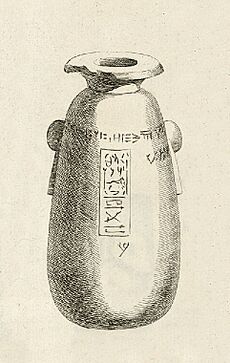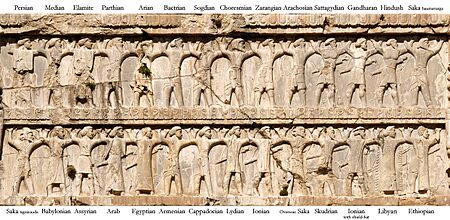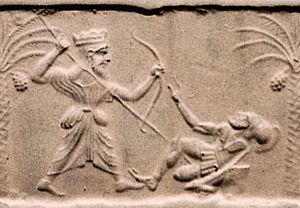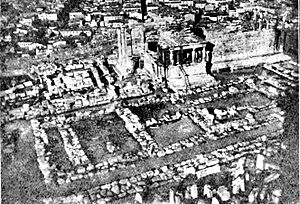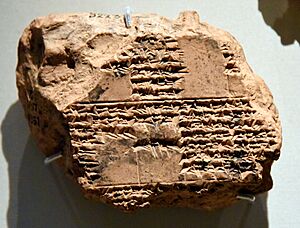Xerxes I facts for kids
Quick facts for kids Xerxes IXšayār̥šā 𐎧𐏁𐎹𐎠𐎼𐏁𐎠 |
|
|---|---|
|
|
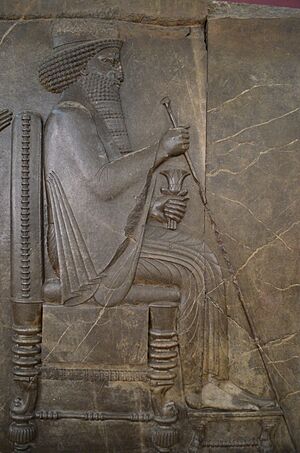
Rock relief of Xerxes I, found in Persepolis, kept at National Museum of Iran
|
|
| King of Kings of the Achaemenid Empire Pharaoh of Egypt |
|
| Reign | October 486 – August 465 BC |
| Predecessor | Darius the Great |
| Successor | Artaxerxes I |
| Born | c. 518 BC |
| Died | August 465 BC (aged approximately 53) |
| Burial | Naqsh-e Rostam |
| Spouse | Amestris |
| Issue |
|
| Dynasty | Achaemenid |
| Father | Darius the Great |
| Mother | Atossa |
| Religion | Indo-Iranian religion (possibly Zoroastrianism) |
Xerxes I (born around 518 BC, died August 465 BC), also known as Xerxes the Great, was a powerful Persian ruler. He was the fourth King of Kings of the Achaemenid Empire. He ruled from 486 BC until he was killed in 465 BC.
Xerxes was the son of Darius the Great and Atossa. Atossa was the daughter of Cyrus the Great, who founded the Persian Empire. In Western history, Xerxes is most famous for his invasion of Greece in 480 BC. This invasion ended with the Persian army being defeated.
Xerxes was chosen by his father Darius to be the next ruler. He became king after Darius died. He made his power strong by stopping revolts in Egypt and Babylon. He then continued his father's plan to take over Greece. He wanted to punish Athens and its allies for helping in the Ionian Revolt.
In 480 BC, Xerxes personally led a huge army. He crossed the Hellespont into Europe. His army won battles at Thermopylae and Artemisium. After this, they captured and burned Athens. His forces controlled mainland Greece north of the Isthmus of Corinth. However, they were defeated at the Battle of Salamis.
Xerxes worried that the Greeks might trap his army in Europe. So, he went back to Asia with most of his army. He left Mardonius to continue the fight. Mardonius was defeated at Plataea the next year. This battle effectively ended the Persian invasion of Greece.
After returning to Persia, Xerxes started many large building projects. Many of these had been started by his father. He finished the Gate of All Nations, the Apadana, and the Tachara at Persepolis. He also continued building the Palace of Darius at Susa. He also kept up the Royal Road that his father had built. In 465 BC, Xerxes was killed by Artabanus. Artabanus was the commander of the royal bodyguard. Xerxes' third son, Artaxerxes I, became the next king.
Contents
What's in a Name?
The name Xerxes comes from the Greek and Latin languages. It is a way of writing the Old Iranian name Xšaya-ṛšā. This name means "ruling over heroes." The first part, xšaya, means "ruling." The second part, ṛšā, means "hero" or "man."
Xerxes' name was also known in other ancient languages. In Akkadian, it was Ḫi-ši-ʾ-ar-šá. In Aramaic, it was ḥšyʾrš. The name Xerxes became popular for other rulers in the Achaemenid Empire later on.
Xerxes' Early Life
His Family and Birth
Xerxes' father was Darius the Great. Darius was the king of the Achaemenid Empire. Xerxes' mother was Atossa, who was the daughter of Cyrus the Great. Cyrus was the person who started the whole empire. Darius and Atossa got married in 522 BC. Xerxes was born around 518 BC.
How Persian Princes Were Raised
Persian princes, like Xerxes, were taught by special teachers. From age seven, they learned important skills. These included how to ride horses and how to hunt. When they turned fourteen, they had four teachers. These teachers taught them how to be "wise, fair, careful, and brave."
Princes also learned the basics of the Zoroastrian religion. This religion taught them to be truthful, courageous, and to have self-control. They learned that being afraid was like being a slave.
At 16 or 17, they began 10 years of national service. This included practicing archery and javelin throwing. They also competed in games and went hunting. After this, they served in the military for about 25 years. Then, they became elders and advisers to the king. Families, including Xerxes' family, often married relatives to keep power within the family.
Becoming King
Darius, Xerxes' father, was getting ready for another war against Greece. But a revolt started in Egypt in 486 BC. This was because of high taxes and workers being sent away. Persian law said the king had to choose his successor before dangerous trips. So, Darius chose Xerxes, his oldest son with Atossa, to be the next king.
Darius became too sick to lead the campaign. He died in October 486 BC, when he was 64. Xerxes' older brother, Artobazan, thought he should be king. But Xerxes argued that he was the son of Atossa, Cyrus the Great's daughter. Cyrus had given the Persians their freedom.
A Spartan king who was in Persia supported Xerxes. He said that the oldest son was not always the best choice. He pointed out that in Sparta, the first son born after the father became king was the heir. Xerxes was the oldest son born after Darius became king. Also, Xerxes' mother was the founder's daughter, which gave him more respect.
Xerxes became king in October–December 486 BC. He was about 32 years old. The change of power to Xerxes was smooth. No one at court or in the royal family challenged him.
Making His Power Strong

When Xerxes became king, there were problems in some parts of his empire. A revolt happened in Egypt. This revolt seemed serious enough for Xerxes to lead his army there himself. This also gave him a chance to start his rule with a military victory.
Xerxes stopped the revolt in January 484 BC. He made his brother, Achaemenes, the new governor of Egypt. The army used to stop the Egyptian revolt had been gathered by Darius. So, Xerxes had to raise a new army for his trip to Greece. This took another four years.
There were also problems in Babylon. They revolted at least twice against Xerxes. The first revolt was in June or July of 484 BC. It was led by a rebel named Bel-shimanni. This revolt lasted only about two weeks.
Two years later, Babylon had another rebel leader, Shamash-eriba. In the summer of 482 BC, Shamash-eriba took over Babylon and other nearby cities. He was finally defeated in March 481 BC after a long siege of Babylon. The exact reason for these revolts is not fully known. It might have been because of higher taxes.
Before these revolts, Babylon had a special place in the Persian Empire. The Persian kings were called "King of Babylon" and "King of the Lands." This meant Babylon was seen as somewhat separate, but joined with their kingdom. After the revolts, Xerxes stopped using the title "King of Babylon." He also divided the large Babylonian region into smaller parts.
Some old writings say that Xerxes was very harsh on Babylon after the revolts. They claim he destroyed Babylon's walls and damaged its temples. The Esagila temple was supposedly badly hurt. Xerxes was also said to have taken the statue of Marduk from the city. Some thought he melted it down because it was made of gold.
Modern historians think it's unlikely Xerxes destroyed the temples. The stories might come from people who disliked Persians. It's also not certain if the statue was removed at all. Some even suggest that if a statue was taken, it might have been a golden statue of a man, not the god Marduk. Even though there are fewer mentions of it, old documents suggest that Babylon's New Year's Festival continued during Persian rule.
Military Campaigns
The Invasion of Greece
Darius died while preparing to invade Greece again. He left his son Xerxes the job of punishing the Athenians, Naxians, and Eretrians. These groups had interfered in the Ionian Revolt, burned the city of Sardis, and beaten the Persians at Marathon.
From 483 BC, Xerxes got ready for his trip. He had the Xerxes Canal dug through the land near Mount Athos. Supplies were stored along the road through Thrace. Two pontoon bridges were built across the Hellespont. Soldiers from many different lands served in Xerxes' army. These included people from Assyria, Phoenicia, Babylon, Egypt, and many more.
According to the Greek historian Herodotus, Xerxes' first attempt to build a bridge across the Hellespont failed. A storm destroyed the ropes of the bridges. In anger, Xerxes ordered the Hellespont (the water itself) to be whipped 300 times. He also had chains thrown into the water. Xerxes' second attempt to bridge the Hellespont was successful.
The Carthaginian invasion of Sicily meant Greece lost help from powerful rulers there. Many smaller Greek states also sided with the Persians. These included Thessaly, Thebes, and Argos. Xerxes won the first battles.
Xerxes started his invasion in the spring of 480 BC from Sardis. He had a fleet of ships and a huge army. Herodotus said the army was about one million strong. It also included 10,000 elite warriors called the Immortals. More recent estimates suggest the Persian force was around 60,000 fighters.
The Battle of Thermopylae and Athens
At the Battle of Thermopylae, a small group of Greek warriors fought against the much larger Persian forces. They were led by King Leonidas of Sparta. The Greeks were eventually defeated. Herodotus says that a Greek man named Ephialtes betrayed his country. He told the Persians about another path around the mountains.
At Artemisium, big storms damaged Greek ships. So the battle ended early. The Greeks heard about the defeat at Thermopylae and pulled back.
After Thermopylae, Athens was captured. Most Athenians had left the city and fled to the island of Salamis. A small group tried to defend the Athenian Acropolis, but they were defeated. Xerxes ordered the Destruction of Athens and burned the city. This left a layer of destruction that archaeologists have found. The Persians then controlled all of mainland Greece north of the Isthmus of Corinth.
Battles of Salamis and Plataea
Xerxes was convinced to attack the Greek fleet. This was against the advice of Artemisia of Halicarnassus. The Battle of Salamis (September 480 BC) was won by the Greek fleet. After this, Xerxes set up a winter camp in Thessaly.
Herodotus says that Xerxes feared the Greeks might attack the bridges over the Hellespont. He worried his army would be trapped in Europe. So, Xerxes decided to go back to Asia. He took most of his army with him. Another reason for his retreat might have been ongoing problems in Babylon. This important part of the empire needed the king's attention.
He left a group of soldiers in Greece to finish the fight. This group was led by Mardonius. Mardonius was defeated the next year at Plataea. The combined forces of the Greek city-states won this battle. This ended the Persian attack on Greece for good.
Building Projects

After his military setbacks in Greece, Xerxes went back to Persia. He focused on finishing many building projects. His father had started these projects at Susa and Persepolis.
Xerxes oversaw the building of the Gate of All Nations. He also built the Hall of a Hundred Columns at Persepolis. These are the largest and most impressive buildings in the palace. He finished the Apadana, the Tachara (Darius' Palace), and the Treasury. All of these had been started by Darius. Xerxes also had his own palace built. It was twice the size of his father's.
His style of building was like Darius'. But Xerxes built on an even bigger scale. He had colorful, shiny bricks put on the outside of the Apadana. He also kept up the Royal Road that his father had built. He finished the Susa Gate and built a palace in Susa.
Death and Who Ruled Next
In August 465 BC, Xerxes was killed. He was assassinated by Artabanus. Artabanus was the commander of the royal bodyguard. He was also a very powerful official in the Persian court. A servant called Aspamitres helped him.
Greek historians tell different stories about what happened. One story says Artabanus blamed Darius, Xerxes' oldest son, for the murder. He then convinced another of Xerxes' sons, Artaxerxes, to kill Darius to get revenge. Another story says Artabanus killed Darius first, then Xerxes. After Artaxerxes found out the truth, he killed Artabanus and his sons. A general named Megabyzus also played a part in these events. His choice to switch sides likely saved the Persian throne for the Achaemenid family.
Religion
It's not fully agreed upon by experts whether Xerxes and the kings before him were influenced by Zoroastrianism. However, it is clear that Xerxes strongly believed in Ahura Mazda. He saw Ahura Mazda as the most important god. Ahura Mazda was also worshipped by followers of the (Indo-)Iranian religious tradition.
When it came to other religions, Xerxes followed the same rules as the kings before him. He listened to local religious leaders. He made offerings to local gods. He also destroyed temples in cities and countries that caused trouble.
Xerxes' Family
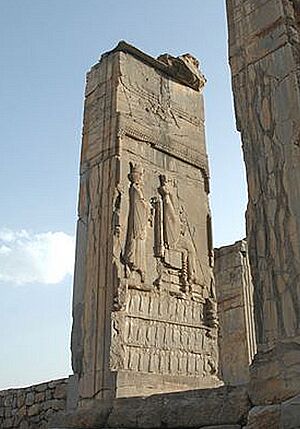
With Queen Amestris:
- Darius, his first son, who was killed.
- Hystaspes, also killed.
- Artaxerxes I
- Achaemenes, killed by Egyptians.
- Rhodogune
- Amytis, who was married to Megabyzus.
With other wives or partners:
- Artarius, a governor of Babylon.
- Tithraustes
- Arsames, a governor of Egypt.
- Parysatis
- Ratashah
See also
 In Spanish: Jerjes I para niños
In Spanish: Jerjes I para niños
- List of biblical figures identified in extra-biblical sources


